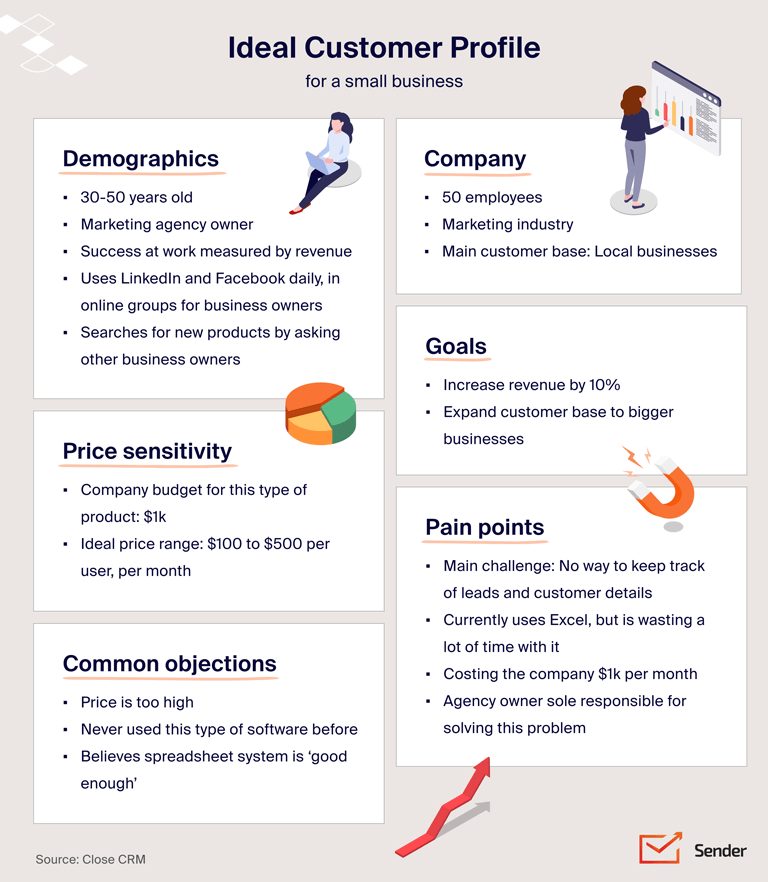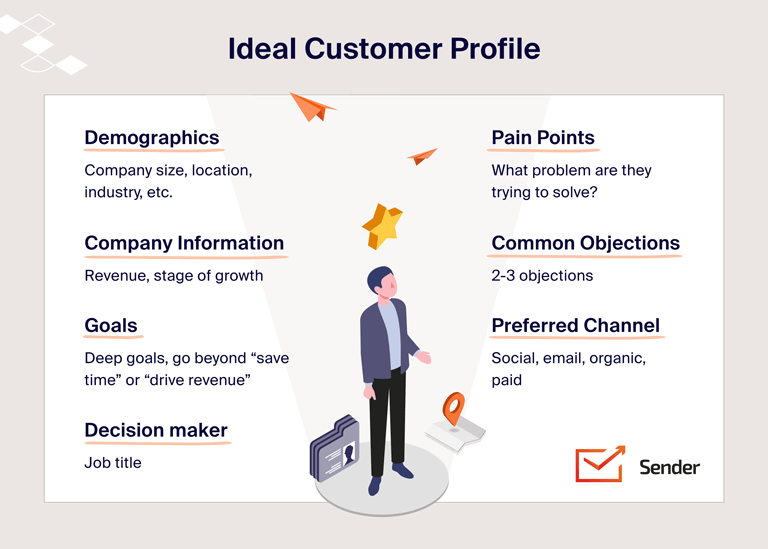Imagine heading to Target to shop for a birthday gift – but you have no idea who you’re shopping for. Would they like the new Taylor Swift album? A meditation journal? A beard trimmer? Without knowing their interest or even their age, it’s impossible to know what they’ll like.
That’s the same feeling your team faces without a well-defined Ideal Customer Profile (ICP).
Identifying your ideal customers is about more than just demographics or general target groups. And it’s definitely about more than “we sell to everyone!” Armed with a killer Ideal Customer Profile, you’ll be able to focus efforts on customers who’re most likely to convert and become loyal advocates for your brand.
Let’s get to it!
What is an Ideal Customer Profile?
An ideal customer profile (ICP) is a detailed description of the type of customer most likely to be interested in your product – and, therefore, more likely to become your customers.
A useful ICP dives deep into specific characteristics, pain points, and behaviors of your target audience. Here’s an example of an ICP for a small business:

Notice this ICP example includes demographic data but also more details on how they’re concerned about budget, how many users they have, and specific goals they have to improve productivity by 10 percent. This detailed information is crucial for ensuring your team knows exactly what to say and how to approach your ideal customers.
ICPs vs. Buyer Personas: What’s the Difference?
ICPs and buyer personas are often used interchangeably, but there are some key differences to be aware of.
A buyer persona is a fictional representation of an individual within your target audience, including a location, job description, and other demographic data. An ideal customer profile represents the overall characteristics of your most valuable customers.
Think of a buyer persona as a specific person and an ICP as a group of people with similar traits. This chart breaks down the differences between an ICP and a buyer persona:
| Ideal Customer Profile | Buyer Persona |
| General profile of a customer most likely to convert | Fictional, specific example of a potential customer |
| Includes company size, industry, pain points, price sensitivity | Includes a name, job title, interests, and demographic data |
| Used mostly by B2B companies | Used by both B2B and B2C |
| Focuses on opportunity for the company | Focuses on the individual behind the purchase |
| Based on data and stats | Based on customer interviews + demographic data |
Why Do You Need an Ideal Customer Profile?
When you know who your ideal customer is, you can tailor your sales and marketing strategy according to their needs. In fact, a great ICP can impact every team, every campaign, and every stage of the sales process.
For example, you might use your ICP while creating:
- Landing pages
- Email marketing copy
- Follow up emails
- Cold call scripts
- Paid ad copy
- Help documentation
- Sales and support team training
How Do You Create an Ideal Customer Profile?
So now we know what ICP is and why it’s important, but how do you create one? Follow these steps, and you’ll have a great ICP in a blink of an eye!
1. Perform Market Research
Start by researching your target market and understanding its dynamics. Analyze existing customers’ demographics, psychographics, and behavior patterns to understand who they are and what they need.
For example, if your target market is SMB, find out where they’re likely to be located, what types of products or sales tools they use, what problems they face, and how many people they likely have on their team. While there will be some variance, you should start to see patterns in the types of consumers most likely to be interested in your offering.
2. Analyze Customer Data
Next, deeply dive into your current customers. Analyze internal customer data from tools like your CRM (Customer Relationship Management), website analytics platforms, and social media accounts. Look for patterns that indicate which customers are most engaged, satisfied, and valuable to your business. Lead scoring metrics can also highlight your most valuable customers.
Keep in mind that the most valuable customers might not be the ones that purchase the highest-end products or the biggest software packages. Consider other factors like time to close, customer churn, and lifetime value.
4. Note Commonalities
Now that you’ve examined market and customer data – compare the two. Pay attention to traits your highest-value customers share–are they more likely to have a large or small team? Are they at a specific stage of growth? Are they more or less likely to have specific pain points? Are they sensitive to pricing?
Examine their shared characteristics, pain points, goals, and challenges. Identify what drives them to seek solutions and how your company can address those needs effectively.
5. Create a Customer Profile
Now it’s time to put all that data you’ve gathered into a profile. Combine the insights you’ve discovered to create a detailed customer profile. This profile should include key demographic information, professional details, pain points, goals, motivations, and preferred communication channels. If this sounds overwhelming, don’t worry – we’ll share an easy-to-use template in the next section.
6. Validate Your ICP
Is your ICP hitting the mark? Contact existing customers or conduct surveys to determine if the ICP is accurate. Ask them if they actually have the paint points, goals, and motivations you think they do. The whole point is to ensure your assumptions about your audience line up with reality. You may find, for example, that your ideal customers aren’t worried about price like you thought; rather they’re struggling to prove the value your solution offers. Your sales, marketing, and support team may also be useful at this step.
Continually refine your ideal customer profile based on new data, market trends, and customer feedback. Stay adaptable and update your profile as your base changes and you gain a deeper understanding of your customers.
Quick Ideal Customer Profile Template
Once you have gathered qualitative and quantitative data, it’s time to create your ideal customer profile. Compile all your info into a detailed description representing your target audience. Include demographics, job titles, pain points, goals, preferred communication channels, and any other relevant characteristics.
This template will help ensure you include all the required information:

Ideal Customer Profile Identification Questions
When you’re crafting an ideal customer profile, asking questions is a smart move. It’s all about making sure your assumptions hold up, spotting any hurdles that might come your way, and staying nimble in a market that’s constantly shifting. It’s a crucial step that’ll give you the lowdown on your target audience and help you serve them like a pro.
Here are a few questions to ask yourself while creating your ideal customer profile.
- Who is the customer that derives the most value from our product/service?
- What industries do our most successful customers come from?
- What are the common pain points our customers experience?
- How does our solution address those pain points?
- What are the key demographics and job titles of our ideal customers?
- What are the job titles of the decision-makers within the company?
- Where can we find these customers and how can we reach them effectively?
- How are these customers most likely to find out about our offering?
Do You Know Who Your Customers Really Are?
It’s easy to assume you know your customers. Defining your ICP ensures your company makes smart, data-backed business decisions rather than assuming. As you navigate the process we laid out above, you might find you do know who your customers are. If so, that’s great! However, there’s a good chance you’ll uncover a goal, pain point, or objection you weren’t aware of.
Use this information to refine your sales and marketing strategies and connect with your customers on an authentic level.
Also read:
- What is a Prospective Customer? Definition, Examples
- What is Customer Segmentation? Definition, Examples & Tools
- What is Customer Engagement? Definition, Importance
- Account Based Marketing (ABM): The Complete Guide
- What is a Squeeze Page? Definition, Examples
Author Bio
Danielle Antosz is an SEO and content marketing specialist at Close CRM with more than 13 years of expertise working with B2B, tech, and SaaS companies.





